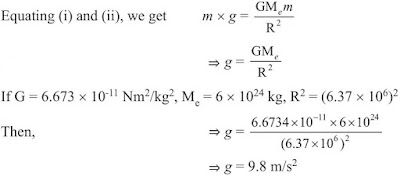- Books Name
- Science Made Easy Science Book
- Publication
- Science Made Easy
- Course
- CBSE Class 9
- Subject
- Science
Gravitational Acceleration and its value at the surface of earth
→ The uniform acceleration produced in a freely falling object due to the gravitational force of
earth, is called acceleration due to gravity.
→ It is represented by ‘g’ and it always acts towards the centre of the earth.
Mathematical Expression for g
From the second law of motion, force is the product of mass and acceleration.
F = ma
For free fall, acceleration is replaced by acceleration due to gravity.
Therefore, force becomes:
F = mg ….(i)
But from Universal Law of Gravitation,

Factors Affecting the Value of g
- As the radius of the earth increases from the poles to the equator, the value of g becomes greater at the poles than at the equator.
- As we go at large heights, value of g decreases.
To Calculate the Value of g
Value of universal gravitational constant, G = 6.7 × 10–11 N m2/ kg2,
Mass of the earth, M = 6 × 1024 kg, and
Radius of the earth, R = 6.4 × 106 m
Putting all these values in equation (iii), we get:

Thus, the value of acceleration due to gravity of the earth, g = 9.8 m/s2.
Mass:
• Mass of an object is the measure of its inertia.
• It is the matter present in it. It remains the same everywhere in the universe.
Weight:
• The force of attraction of the earth on the object is known as the weight of the object.
• It’s S.I. unit is Newton.
W = m x g
Thrust:
• The force that acts in the perpendicular direction is called thrust.
• It is similar to force applied to an object
• It is a vector quantity.
Pressure
• The force that acts per unit area of the object is pressure.
• It is the thrust per unit area.
• Pressure is denoted by ‘P'
• P = thrust/ area = force/ area = F/A
• SI unit: N/m2 or Pa (Pascal)
Applications of pressure
• The base of high buildings is made wider so that weight of the walls act over a large surface area and pressure is less.
• School bags are having broad strap so that the weight of the school bags fall over a large area of shoulder and produce less pressure and become less painful.
• All liquids and gases exist pressure in all direction.

 Science Made Easy
Science Made Easy
